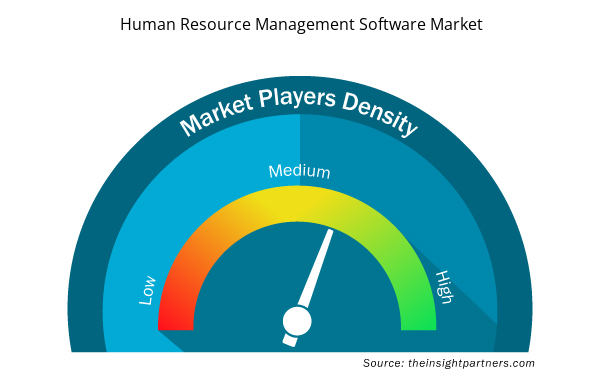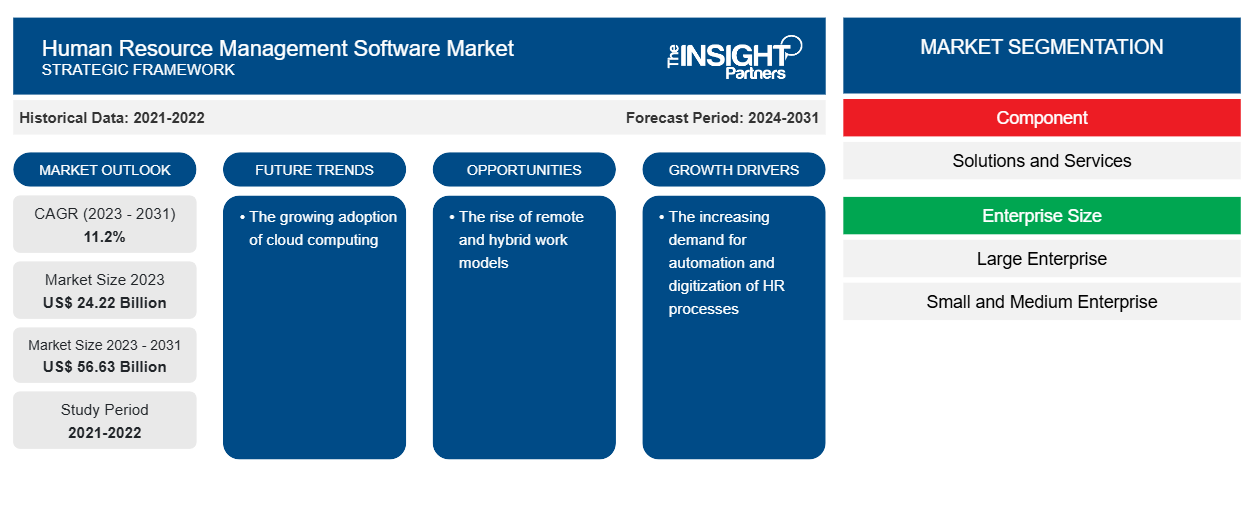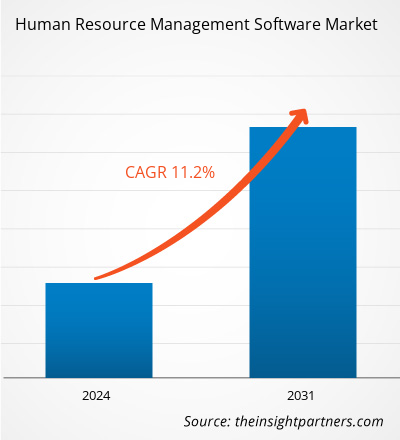Si prevede che la dimensione del mercato del software di gestione delle risorse umane raggiungerà i 56,63 miliardi di dollari entro il 2031, rispetto ai 24,22 miliardi di dollari del 2023. Si prevede che il mercato registrerà un CAGR dell'11,2% nel 2023-2031. È probabile che la crescente adozione del cloud computing rimanga una tendenza chiave del mercato del software di gestione delle risorse umane.
Analisi di mercato del software di gestione delle risorse umane
Ci sono diverse tendenze chiave nel mercato delle risorse umane, come l'analisi basata sull'intelligenza artificiale per la gestione dei talenti, l'ascesa di HRMS basati su cloud e piattaforme mobile-friendly che si rivolgono a forze lavoro remote. Il mercato è categorizzato da un focus sull'esperienza utente e sulla forte concorrenza, capacità di integrazione e sicurezza dei dati. Poiché le organizzazioni danno priorità alla produttività e all'impegno dei dipendenti, si prevede che il mercato HRMS continuerà a espandersi in tutto il mondo.
Panoramica del mercato del software di gestione delle risorse umane
Il software di gestione delle risorse umane (HRM) modernizza diverse funzioni HR per migliorare l'efficienza e l'efficacia nella gestione dei dipendenti. Queste piattaforme in genere includono moduli per l'elaborazione delle buste paga, il monitoraggio delle presenze, la gestione delle prestazioni, il reclutamento, l'inserimento e il self-service dei dipendenti. Il software HRM facilita anche la conformità alle leggi e ai regolamenti sul lavoro. Le funzionalità chiave spesso presenti nel software HRM includono solide capacità di reporting e analisi per ricavare informazioni dai dati della forza lavoro, il che aiuta nel processo decisionale. Molte piattaforme offrono soluzioni basate su cloud, consentendo l'accesso remoto e la scalabilità. I fornitori di software HRM più diffusi includono Workday, ADP, BambooHR e SAP SuccessFactors, ognuno dei quali offre soluzioni personalizzate per aziende di diverse dimensioni e settori. L'implementazione del software HRM può portare a un migliore coinvolgimento dei dipendenti, a una riduzione degli oneri amministrativi e a operazioni HR semplificate. Tuttavia, la scelta del software giusto richiede la considerazione di fattori quali scalabilità, capacità di integrazione con i sistemi esistenti ed esperienza utente.
Personalizza questo report in base alle tue esigenze
Riceverai la personalizzazione gratuita di qualsiasi report, comprese parti di questo report, o analisi a livello nazionale, pacchetto dati Excel, oltre a usufruire di grandi offerte e sconti per start-up e università
- Scopri le principali tendenze di mercato in questo rapporto.Questo campione GRATUITO includerà analisi di dati che spaziano dalle tendenze di mercato alle stime e alle previsioni.
Driver e opportunità di mercato del software di gestione delle risorse umane
La crescente domanda di automazione e digitalizzazione dei processi HR
Mentre le organizzazioni cercano di semplificare le operazioni e migliorare l'efficienza, il software HRM offre soluzioni per la gestione delle buste paga, il coinvolgimento dei dipendenti, la valutazione delle prestazioni e l'acquisizione di talenti. La necessità di una gestione centralizzata dei dati e di analisi per supportare il processo decisionale strategico spinge anche l'adozione del software HRM.HRM software offers solutions for payroll management, employee engagement, performance evaluation, and talent acquisition. The need for centralized data management and analytics to support strategic decision-making also propels the adoption of HRM software.
L’ascesa dei modelli di lavoro remoto e ibrido
Con il passaggio a modalità di lavoro flessibili, le organizzazioni necessitano di strumenti HRM che facilitino la gestione della forza lavoro da remoto, la collaborazione e la comunicazione. Il software HRM può abilitare iniziative di onboarding remoto senza soluzione di continuità, formazione virtuale e coinvolgimento dei dipendenti. Man mano che le aziende si adattano a nuovi paradigmi di lavoro, i fornitori di software HRM hanno l'opportunità di innovare e offrire soluzioni che rispondano alle esigenze in continua evoluzione dei team distribuiti, migliorando la produttività e la soddisfazione dei dipendenti. Pertanto, si prevede che l'ascesa di modelli di lavoro da remoto e ibridi presenterà nuove opportunità per gli operatori del mercato del software di gestione delle risorse umane durante il periodo di previsione.HRM tools that facilitate remote workforce management, collaboration, and communication. HRM software can enable seamless remote onboarding, virtual training, and employee engagement initiatives. As businesses adapt to new work paradigms, HRM software providers have the opportunity to innovate and offer solutions that address the evolving needs of distributed teams, enhancing productivity and employee satisfaction. Thus, the rise of remote and hybrid work models is anticipated to present new opportunities for the human resource management software market players during the forecast period.
Analisi della segmentazione del rapporto di mercato del software di gestione delle risorse umane
I segmenti chiave che hanno contribuito alla derivazione dell'analisi di mercato del software di gestione delle risorse umane sono i componenti, le dimensioni dell'azienda e gli utenti finali.
- In base ai componenti, il mercato del software per la gestione delle risorse umane è segmentato in soluzioni e servizi.
- In base alle dimensioni aziendali, il mercato è segmentato in grandi imprese, piccole e medie imprese. Il segmento delle grandi imprese ha detenuto una quota di mercato maggiore nel 2023.
- In base all'utente finale, il mercato è segmentato in istituti scolastici, BFSI, governo, sanità, IT e telecomunicazioni , produzione, vendita al dettaglio e altri.BFSI, government, healthcare, IT and
Analisi della quota di mercato del software di gestione delle risorse umane per area geografica
L'ambito geografico del rapporto di mercato del software di gestione delle risorse umane è suddiviso principalmente in cinque regioni: Nord America, Asia Pacifico, Europa, Medio Oriente e Africa e Sud America/Sud e Centro America. In termini di fatturato, il Nord America ha rappresentato la quota di mercato più grande del software di gestione delle risorse umane. In Nord America, in particolare negli Stati Uniti e in Canada, una crescita robusta è guidata dalle grandi aziende che adottano suite HRM integrate per l'acquisizione di talenti, la gestione delle buste paga e il coinvolgimento dei dipendenti.
Approfondimenti regionali sul mercato del software di gestione delle risorse umane
Le tendenze regionali e i fattori che influenzano il mercato del software di gestione delle risorse umane durante il periodo di previsione sono stati ampiamente spiegati dagli analisti di Insight Partners. Questa sezione discute anche i segmenti del mercato del software di gestione delle risorse umane e la geografia in Nord America, Europa, Asia Pacifico, Medio Oriente e Africa e America meridionale e centrale.

- Ottieni i dati specifici regionali per il mercato del software di gestione delle risorse umane
Ambito del rapporto di mercato sul software di gestione delle risorse umane
| Attributo del report | Dettagli |
|---|---|
| Dimensioni del mercato nel 2023 | 24,22 miliardi di dollari USA |
| Dimensioni del mercato entro il 2031 | 56,63 miliardi di dollari USA |
| CAGR globale (2023-2031) | 11,2% |
| Dati storici | 2021-2022 |
| Periodo di previsione | 2024-2031 |
| Segmenti coperti | Per componente
|
| Regioni e Paesi coperti | America del Nord
|
| Leader di mercato e profili aziendali chiave |
|
Densità dei player del mercato del software di gestione delle risorse umane: comprendere il suo impatto sulle dinamiche aziendali
Il mercato del software di gestione delle risorse umane sta crescendo rapidamente, spinto dalla crescente domanda degli utenti finali dovuta a fattori quali l'evoluzione delle preferenze dei consumatori, i progressi tecnologici e una maggiore consapevolezza dei vantaggi del prodotto. Con l'aumento della domanda, le aziende stanno ampliando le loro offerte, innovando per soddisfare le esigenze dei consumatori e capitalizzando sulle tendenze emergenti, il che alimenta ulteriormente la crescita del mercato.
La densità degli operatori di mercato si riferisce alla distribuzione di aziende o società che operano in un particolare mercato o settore. Indica quanti concorrenti (operatori di mercato) sono presenti in un dato spazio di mercato in relazione alle sue dimensioni o al valore di mercato totale.
Le principali aziende che operano nel mercato del software per la gestione delle risorse umane sono:
- Elaborazione automatica dei dati, Inc.
- SAP SE
- Società Oracle
- Giorno lavorativo, Inc.
- Società di gestione Ceridian HCM
- Cezanne HR Limited
Disclaimer : le aziende elencate sopra non sono classificate secondo un ordine particolare.

- Ottieni una panoramica dei principali attori del mercato dei software di gestione delle risorse umane
Notizie di mercato e sviluppi recenti del software di gestione delle risorse umane
Il mercato del software di gestione delle risorse umane viene valutato raccogliendo dati qualitativi e quantitativi dopo la ricerca primaria e secondaria, che include importanti pubblicazioni aziendali, dati associativi e database. Di seguito è riportato un elenco degli sviluppi nel mercato dei disturbi e delle strategie del linguaggio e della parola:
- Nell'aprile 2023, Pocket HRMS ha annunciato il lancio della sua missione Bharat 2.0 per consentire alle PMI in India di digitalizzare il loro HRMS completo, il sistema di gestione delle paghe e le relative conformità con un software HR intuitivo e facile da usare sulla piattaforma di messaggistica WhatsApp nelle lingue regionali indiane. (Fonte: Pocket HRMS, comunicato stampa)
- A gennaio 2024, OrangeHRM, un fornitore leader di soluzioni di gestione delle risorse umane, ha annunciato il lancio del suo helpdesk abilitato all'intelligenza artificiale, un'aggiunta rivoluzionaria alla sua versione avanzata. Accessibile tramite il portale di assistenza HRM, questa funzionalità innovativa segna una pietra miliare significativa nell'impegno di OrangeHRM nello sfruttare l'intelligenza artificiale per migliorare l'esperienza utente. (Fonte: OrangeHRM, comunicato stampa)
Copertura e risultati del rapporto di mercato sul software di gestione delle risorse umane
Il rapporto "Dimensioni e previsioni del mercato del software di gestione delle risorse umane (2023-2031)" fornisce un'analisi dettagliata del mercato che copre le seguenti aree:
- Dimensioni del mercato e previsioni a livello globale, regionale e nazionale per tutti i segmenti di mercato chiave coperti dall'ambito
- Dinamiche di mercato come fattori trainanti, vincoli e opportunità chiave
- Principali tendenze future
- Analisi dettagliata delle cinque forze PEST/Porter e SWOT
- Analisi di mercato globale e regionale che copre le principali tendenze di mercato, i principali attori, le normative e gli sviluppi recenti del mercato
- Analisi del panorama industriale e della concorrenza che copre la concentrazione del mercato, l'analisi della mappa di calore, i principali attori e gli sviluppi recenti
- Profili aziendali dettagliati
- Analisi storica (2 anni), anno base, previsione (7 anni) con CAGR
- Analisi PEST e SWOT
- Valore/volume delle dimensioni del mercato - Globale, regionale, nazionale
- Industria e panorama competitivo
- Set di dati Excel



Report Coverage
Revenue forecast, Company Analysis, Industry landscape, Growth factors, and Trends

Segment Covered
This text is related
to segments covered.

Regional Scope
North America, Europe, Asia Pacific, Middle East & Africa, South & Central America

Country Scope
This text is related
to country scope.
Domande frequenti
The global human resource management software market is expected to reach US$ 56.63 billion by 2031.
The growing adoption of cloud computing is anticipated to play a significant role in the global human resource management software market in the coming years.
The key players holding majority shares in the global human resource management software market are Automatic Data Processing, Inc., SAP SE, Oracle Corporation, Workday, Inc., and Ceridian HCM Holding Inc.
The global human resource management software market was estimated to be US$ 24.22 billion in 2023 and is expected to grow at a CAGR of 11.2 % during the forecast period 2023 - 2031.
The increasing demand for automation and digitization of HR processes and the rise of remote and hybrid work models are the major factors that propel the global human resource management software market.
Trends and growth analysis reports related to Technology, Media and Telecommunications : READ MORE..
The Insight Partners performs research in 4 major stages: Data Collection & Secondary Research, Primary Research, Data Analysis and Data Triangulation & Final Review.
- Data Collection and Secondary Research:
As a market research and consulting firm operating from a decade, we have published and advised several client across the globe. First step for any study will start with an assessment of currently available data and insights from existing reports. Further, historical and current market information is collected from Investor Presentations, Annual Reports, SEC Filings, etc., and other information related to company’s performance and market positioning are gathered from Paid Databases (Factiva, Hoovers, and Reuters) and various other publications available in public domain.
Several associations trade associates, technical forums, institutes, societies and organization are accessed to gain technical as well as market related insights through their publications such as research papers, blogs and press releases related to the studies are referred to get cues about the market. Further, white papers, journals, magazines, and other news articles published in last 3 years are scrutinized and analyzed to understand the current market trends.
- Primary Research:
The primarily interview analysis comprise of data obtained from industry participants interview and answers to survey questions gathered by in-house primary team.
For primary research, interviews are conducted with industry experts/CEOs/Marketing Managers/VPs/Subject Matter Experts from both demand and supply side to get a 360-degree view of the market. The primary team conducts several interviews based on the complexity of the markets to understand the various market trends and dynamics which makes research more credible and precise.
A typical research interview fulfils the following functions:
- Provides first-hand information on the market size, market trends, growth trends, competitive landscape, and outlook
- Validates and strengthens in-house secondary research findings
- Develops the analysis team’s expertise and market understanding
Primary research involves email interactions and telephone interviews for each market, category, segment, and sub-segment across geographies. The participants who typically take part in such a process include, but are not limited to:
- Industry participants: VPs, business development managers, market intelligence managers and national sales managers
- Outside experts: Valuation experts, research analysts and key opinion leaders specializing in the electronics and semiconductor industry.
Below is the breakup of our primary respondents by company, designation, and region:

Once we receive the confirmation from primary research sources or primary respondents, we finalize the base year market estimation and forecast the data as per the macroeconomic and microeconomic factors assessed during data collection.
- Data Analysis:
Once data is validated through both secondary as well as primary respondents, we finalize the market estimations by hypothesis formulation and factor analysis at regional and country level.
- Macro-Economic Factor Analysis:
We analyse macroeconomic indicators such the gross domestic product (GDP), increase in the demand for goods and services across industries, technological advancement, regional economic growth, governmental policies, the influence of COVID-19, PEST analysis, and other aspects. This analysis aids in setting benchmarks for various nations/regions and approximating market splits. Additionally, the general trend of the aforementioned components aid in determining the market's development possibilities.
- Country Level Data:
Various factors that are especially aligned to the country are taken into account to determine the market size for a certain area and country, including the presence of vendors, such as headquarters and offices, the country's GDP, demand patterns, and industry growth. To comprehend the market dynamics for the nation, a number of growth variables, inhibitors, application areas, and current market trends are researched. The aforementioned elements aid in determining the country's overall market's growth potential.
- Company Profile:
The “Table of Contents” is formulated by listing and analyzing more than 25 - 30 companies operating in the market ecosystem across geographies. However, we profile only 10 companies as a standard practice in our syndicate reports. These 10 companies comprise leading, emerging, and regional players. Nonetheless, our analysis is not restricted to the 10 listed companies, we also analyze other companies present in the market to develop a holistic view and understand the prevailing trends. The “Company Profiles” section in the report covers key facts, business description, products & services, financial information, SWOT analysis, and key developments. The financial information presented is extracted from the annual reports and official documents of the publicly listed companies. Upon collecting the information for the sections of respective companies, we verify them via various primary sources and then compile the data in respective company profiles. The company level information helps us in deriving the base number as well as in forecasting the market size.
- Developing Base Number:
Aggregation of sales statistics (2020-2022) and macro-economic factor, and other secondary and primary research insights are utilized to arrive at base number and related market shares for 2022. The data gaps are identified in this step and relevant market data is analyzed, collected from paid primary interviews or databases. On finalizing the base year market size, forecasts are developed on the basis of macro-economic, industry and market growth factors and company level analysis.
- Data Triangulation and Final Review:
The market findings and base year market size calculations are validated from supply as well as demand side. Demand side validations are based on macro-economic factor analysis and benchmarks for respective regions and countries. In case of supply side validations, revenues of major companies are estimated (in case not available) based on industry benchmark, approximate number of employees, product portfolio, and primary interviews revenues are gathered. Further revenue from target product/service segment is assessed to avoid overshooting of market statistics. In case of heavy deviations between supply and demand side values, all thes steps are repeated to achieve synchronization.
We follow an iterative model, wherein we share our research findings with Subject Matter Experts (SME’s) and Key Opinion Leaders (KOLs) until consensus view of the market is not formulated – this model negates any drastic deviation in the opinions of experts. Only validated and universally acceptable research findings are quoted in our reports.
We have important check points that we use to validate our research findings – which we call – data triangulation, where we validate the information, we generate from secondary sources with primary interviews and then we re-validate with our internal data bases and Subject matter experts. This comprehensive model enables us to deliver high quality, reliable data in shortest possible time.


 Ottieni un campione gratuito per questo repot
Ottieni un campione gratuito per questo repot